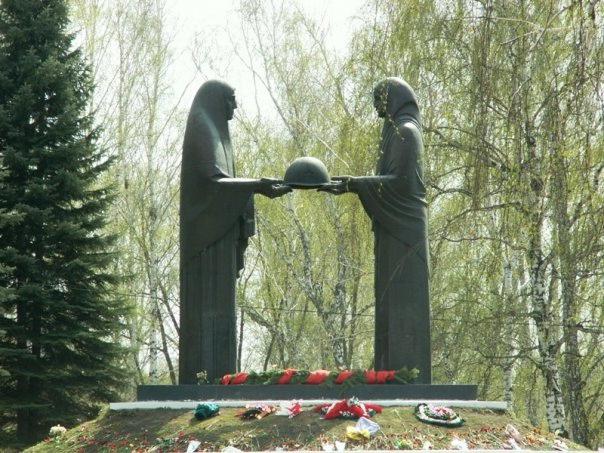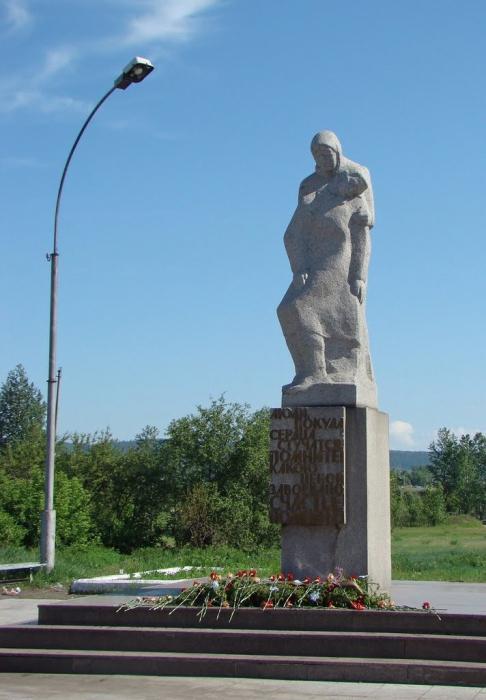Wars arose along with humanity. Soldiers always killed, women who gave birth to them always cried. All peoples have their own
monument to the grieving mother, and have placed them at all times. The clearest example is the “Pieta” (“Mourning Christ”) by Michelangelo. A woman holds in her arms her beloved murdered son, "He only sleeps on the bed of his hands that his mother does not open forever ...". One must possess super genius in order to convey this inhuman grief.
Native Russian monument
Russia, like no other country, suffers from enemy invasions. She always defeats the invaders, but her best sons, the color of the nation, die. This is not to say that our mothers mourn over their sons more than others, but Russian faith, mentality, culture, passed down from generation to generation, make sorrow stronger, higher and cleaner.
Russian mothers mourn not the invaders; they mourn the liberators who gave their lives for the happiness of all peoples. "Monument to the grieving mother" on Mamaev Kurgan is the highest work of art. This is easily verified - you look in the face of this woman, and the tears welling themselves.
Uniqueness of the monument
E.V. Vuchetich is not just brilliant, his work on the Mamaev Kurgan is the greatest tribute to the country and people who stopped fascism. These masterpieces are no less than the masterpieces of the Renaissance masters. The Monument to the Sorrowful Mother, located on the Field of Sorrow, is magnificent. Amazing composition. And, perhaps, the fact that the figures of the mother and son are not completely molded - the upper part of both and the hands, lifeless of the son and twisted in an eternal embrace of the mother, stand out from the stone, emphasizes the power of the tragedy of what happened. The reinforced concrete composition gives the impression of weight, solidity, although the figures are hollow inside. The peculiar "incompleteness" of the composition makes a painful impression. The small lake at the feet of the eleven meter sculpture symbolizes a sea of tears shed by all the mothers of immense Russia, who have lost their sons.
The genius of the people
Only the Russians could so sing the feat of the people and their grief. What can P. Antokolsky’s poem “Son” be compared with, dedicated to the murdered handsome junior lieutenant Vladimir Antokolsky, or the song “Alexey, Alyoshenka, son ...” or R. Rozhdestvensky’s poem “Remember!”? In this series of monuments of a mourning mother, E.V. Vucheticha. The composition of the monument echoes the aforementioned “Drink”. A seated woman holds her son’s lifeless body on her lap. The face of the Soviet warrior is covered with a military banner - a symbol of military feat, the woman's head is tilted, the whole figure is pierced with sorrow. The grief that does not abate over the years is striking at first sight. But how the author fashioned his face! It is the tragedy of millions of mothers.
Eternal source of inspiration
A worthy description of the monument to the grieving mother can only be done by a talented person, so that the words produce at least a distant idea of the true impact of this sculpture on visitors. It can be added that a path made of separate stones is laid through the lake, which makes it possible to carry and put flowers at the foot of the monument. And how many verses are born near a grieving mother. There are amazing ones. How beautifully the words of the poetess Niyara Samkova sound - "a monument frozen in stone from tears ...". The mother’s grief is endless, and the words “Lord, as you see, takes the best ...”
Better to see once ...

The complex, together with the sculptor, was created by architects F. M. Lysov, Ya. B. Belopolsky and V. A. Demin. It is difficult to choose words to describe a great creation. Numerous photos taken from different angles can help. Everyone should see the monument to the grieving mother, included in the ensemble “To the Heroes of the Battle of Stalingrad” (1959-1967). The Square of Sorrow with the central figure of the mother (located on the left side, away from the central axis), mourning her son, is located at the foot of the mound, crowned with the dominant sculpture of the entire ensemble "Motherland Calls." Mamaev Kurgan is not in vain called the "main height of Russia." Quite fair was the first place in the contest “7 Wonders of Russia” in 2008. The “Sorrowful Mother” (monument) takes its rightful place in the ensemble. Volgograd is a sacred place for every Russian person, and the ensemble on the Mamaev Kurgan is a worthy tribute to the memory of all those who died during the years of the bloodiest war in
human history .
Scattered throughout the country

In the world, of course, there are still monuments to women who have lost close men, but in Russia there are most of them, and they were erected in honor of their mothers. This is a collective image that embodies the world's grief. In many cities of our country there are such monuments - in large (like Perm, Nakhodka, Zheleznovodsk), in small ones (like Pechory and Novozybkovo). There is also a monument to grieving mothers. Chelyabinsk, 30 years after the war, found the monument “Memory” (another name “Mourning Mothers”), which entered the cultural heritage of the Russian Federation. At the entrance to the city, at the Lesnoe cemetery, which is located near the Furniture Village, soldiers who died of wounds in a local hospital are buried. Doctors managed to return to life 150 thousand soldiers, but many had wounds that were incompatible with life. The remains of 177 warriors rest in this cemetery. In 1975, it was here that a memorial was opened in memory of the victims. The monument is peculiar, unique. Two women facing each other carefully hold the helmet of the killed soldier. The figures of mothers are made of forged copper, they reach a height of 6 meters. The monument is very beautiful, and there are always fresh flowers.